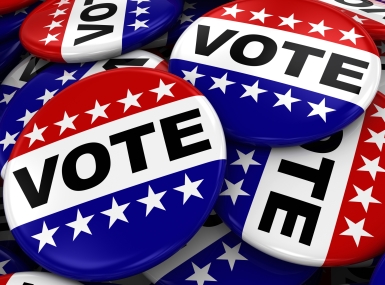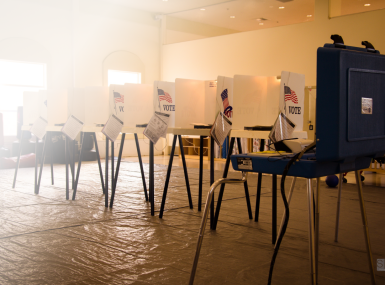Ranked choice voting remains a rarity in county-level races
Key Takeaways
A special election for a congressional seat in Alaska this summer caught national attention in part because of the twists resulting from the state’s debut of a ranked-choice voting system.
A ranked-choice voting system is an electoral system in which voters rank candidates by preference on their ballots. If a candidate wins a majority of first-preference votes, he or she is declared the winner. If no candidate wins a majority of first-preference votes, the candidate with the fewest first-preference votes is eliminated. First-preference votes cast for the failed candidate are eliminated, lifting the second-preference choices indicated on those ballots. A new tally is conducted to determine whether any candidate has won a majority of the adjusted votes. The process is repeated until a candidate wins an outright majority.
For all of the flair that the Alaska race brought to the elections discourse, the system has been slow to spread to county-level races, and in one case did not last long at the county level.
When nine Salt Lake County, Utah municipalities chose ranked choice voting for their elections in 2021, one race in particular showed Clerk Sherrie Swensen where the system broke down in her state.
“We discovered there were problems with our statute, not with the ranked choice process itself,” she said. “Utah did not have an option to rank only two or three candidates, you could rank as many candidates as you wanted.”
Fortunately, five mayoral candidates dropped out, letting the system operate under the wire.
“If we had all 13 candidates who file stay in the race, we would not have the ability with the current system to lay them out and have the choices,” Swensen said.
Ranked choice system creates an instant runoff, where, if no candidate garners more than 50 percent of the votes, the candidate with the fewest number of votes is eliminated and that candidates’ votes are distributed to the voters’ second choice. Voters select candidates in order of their preference.
Proponents tout potential cost savings from not having to conduct separate run-off elections and an increased sense of civility in campaigns. Critics say the process is complicated and requires involved educational outreach to teach voters a new system and some contend that runoff elections are valuable. Most ranked choice systems in the United States serve elections for city, municipal or federal roles.
Thus far, Benton County, Ore. is the only county to currently offer ranked choice voting for county-level elections, though counties in Hawaii will be able to use the system to fill county council vacancies starting in 2023.
Multnomah County, Ore.; King, Clark and San Juan counties in Washington and Arlington County, Va. are considering adopting ranked choice voting, with voters in several counties making the decision in November.
Benton County first used the system for two county commissioner races in 2021, but in Clerk James Morales’ estimation, the races were anticlimactic because the winners both claimed a majority on the first ballot. But the process of preparing the electorate to rank their choices, Morales said, was valuable in and of itself.
“We did receive some pilot funding from the state of Oregon to help with the cost for educating voters and to implement it,” he said. “One of the challenges for me as an election official is prepping for that…before every election, we have logic and accuracy testing of our vote tabulation, so creating that test deck puts ranked choice voting through its paces.”
“The actual counting of the ballots after the fact, that the voters have marked submitted, that’s pretty much the easy part.”
Swensen said Utah’s vote-by-mail system would make wider adoption of ranked choice voting impractical, based solely on the amount of paper it would require.
“The vote for the Sandy City mayor, it took up the whole page of a 14-inch ballot,” she said. “The real estate on a ranked choice contest is very large, so if we try to apply that to our regular elections, for example, this time, for this election we have a double-sided 19-inch ballot and three columns. If we try to apply that in a vote by mail election and use ranked choice and those contest, I don’t even know how many pages it would be.”
Pierce County, Wash. was an early adopter of ranked choice voting in 2006, but voters ended the experiment in 2009 after two elections with the system. The Sightline Institute reported that a court restoration of top-two primaries, the ranked-choice system was unnecessary. The cost of writing new rules, purchasing new equipment and printing twice as many ballots was also a deterrent.
Attachments
Related News

2024 Clearinghouse Awards: U.S. Election Assistance Commission recognizes county excellence in election administration
The U.S. Election Assistance Commission (EAC) announced the winners of its 2024 Clearinghouse awards, recognizing 32 counties for their election administration practices during the 2024 election cycle.

County Countdown – April 7, 2025
Every other week, NACo's County Countdown reviews top federal policy advocacy items with an eye towards counties and the intergovernmental partnership. This week features a budget reconciliation update, HHS restructuring and more.

Both the Administration and Congress act on 'noncitizen voting:' What this could mean for counties
The U.S. House will consider the Safeguard American Voter Eligibility (SAVE) Act this week to require individuals to provide proof of citizenship to register to vote.
